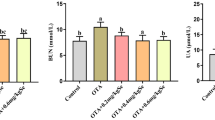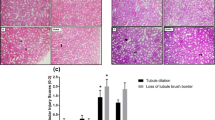Abstract
Systemic inflammation is a serious condition that can affect various tissues and organs, such as the kidneys, and can be life-threatening. Selenium (Se) is an antioxidant and anti-inflammatory trace element. In this study, we aimed to examine the effects of Se, which has antioxidant and anti-inflammatory properties, on lipopolysaccharide (LPS)-induced kidney damage to maintain aquaporin-1 (AQP-1) levels. Four experimental rat groups (n = 8) consisting of the control, LPS alone, LPS + Se, and Se alone were so applied for 7 consecutive days. Upon sacrifice, histopathological results, diagnostic markers of kidney functions, oxidative stress, and inflammation were analyzed. Our results showed that LPS induced mononuclear cell infiltration, cellular residue, and protein deposition in the kidney proximal tubules, and also decreased total antioxidant status levels and increased total antioxidant status and oxidative stress index values. LPS increased the level of creatinine, increased the level of Nuclear Factor kappa B, which has an important role in the inflammation process, and decreased the levels of AQP-1 due to the damage it caused. Se has shown its effect by reversing all these situations. This data suggests that Se can be used as an additive to mitigate LPS-induced toxicity in the kidney.





Similar content being viewed by others
Data Availability
All data generated or analyzed during this study are included in this published article.
References
Kimura T, Isaka Y, Yoshimori T (2017) Autophagy and kidney inflammation. Autophagy 13:997–1003. https://doi.org/10.1080/15548627.2017.1309485
Ali BH, Al-Salam S, Al Suleimani Y et al (2018) Curcumin ameliorates kidney function and oxidative stress in experimental chronic kidney disease. Basic Clin Pharmacol Toxicol 122:65–73. https://doi.org/10.1111/BCPT.12817
Silhavy TJ, Kahne D, Walker S (2010) The bacterial cell envelope. Cold Spring Harb Perspect Biol 2:a000414. https://doi.org/10.1101/cshperspect.a000414
Bertani B, Ruiz N (2018) Function and biogenesis of lipopolysaccharides. EcoSal Plus 8. https://doi.org/10.1128/ECOSALPLUS.ESP-0001-2018
Raetz CRH, Whitfield C (2002) Lipopolysaccharide endotoxins. Annu Rev Biochem 71:635–700. https://doi.org/10.1146/annurev.biochem.71.110601.135414
Ramachandran G (2014) Gram-positive and gram-negative bacterial toxins in sepsis: a brief review. Virulence 5:213–218. https://doi.org/10.4161/viru.27024
Daenen K, Andries A, Mekahli D et al (2019) Oxidative stress in chronic kidney disease. Pediatr Nephrol 34:975–991. https://doi.org/10.1007/s00467-018-4005-4
Birben E, Sahiner UM, Sackesen C et al (2012) Oxidative stress and antioxidant defense. World Allergy Organ J 5:9–19. https://doi.org/10.1097/WOX.0B013E3182439613
Erel O (2004) A novel automated direct measurement method for total antioxidant capacity using a new generation, more stable ABTS radical cation. Clin Biochem 37:277–285. https://doi.org/10.1016/j.clinbiochem.2003.11.015
Elmore S (2007) Apoptosis: a review of programmed cell death. Toxicol Pathol 35:495–516. https://doi.org/10.1080/01926230701320337
Asvapromtada S, Sonoda H, Kinouchi M et al (2018) Characterization of urinary exosomal release of aquaporin-1 and -2 after renal ischemia-reperfusion in rats. Am J Physiol Renal Physiol 314:F584–F601. https://doi.org/10.1152/AJPRENAL.00184.2017/ASSET/IMAGES/LARGE/ZH20011884240015.JPEG
Müller-Deile J, Sopel N, Ohs A et al (2021) Glomerular endothelial cell-derived microRNA-192 regulates nephronectin expression in idiopathic membranous glomerulonephritis. J Am Soc Nephrol 32:2777–2794. https://doi.org/10.1681/ASN.2020121699
Liu Q, Kong Y, Guo X et al (2021) GSK-3β inhibitor TDZD-8 prevents reduction of aquaporin-1 expression via activating autophagy under renal ischemia reperfusion injury. FASEB J 35:e21809. https://doi.org/10.1096/fj.202100549R
Holben DH, Smith AM (1999) The diverse role of selenium within selenoproteins: a review. J Am Diet Assoc 99:836–843. https://doi.org/10.1016/S0002-8223(99)00198-4
Abed El-Gaphar OAM, Abo-Youssef AM, Halal GK (2018) Levetiracetam mitigates lipopolysaccharide-induced JAK2/STAT3 and TLR4/MAPK signaling pathways activation in a rat model of adjuvant- induced arthritis. Eur J Pharmacol 826:85–95. https://doi.org/10.1016/J.EJPHAR.2018.02.041
Shen W, Chen J, Yin J, Wang S-L (2016) Selenium protects reproductive system and foetus development in a rat model of gestational lead exposure. Eur Rev Med Pharmacol Sci 20:773–780
Abdel-Wahhab MA, Nada SA, Arbid MS (1999) Ochratoxicosis: prevention of developmental toxicity by L-methionine in rats. J Appl Toxicol 19:7–12. https://doi.org/10.1002/(sici)1099-1263(199901/02)19:1%3c7::aid-jat529%3e3.0.co;2-g
Lowry OH, Rosebrough NJ, Farr AL, Randall RJ (1951) Protein measurement with the Folin phenol reagent. J Biol Chem 193:265–275. https://doi.org/10.1016/s0021-9258(19)52451-6
Erel O (2005) A new automated colorimetric method for measuring total oxidant status. Clin Biochem 38:1103–1111. https://doi.org/10.1016/j.clinbiochem.2005.08.008
Savas HB (2017) Positive effects of meal frequency and calorie restriction on antioxidant systems in rats. North Clin Istanb 4:109–116. https://doi.org/10.14744/nci.2017.21548
Fatima N, Ali R, Faisal T et al (2023) Macrophage angiotensin AT2 receptor activation is protective against early phases of LPS-induced acute kidney injury. Am J Physiol Renal Physiol 325:F552–F563. https://doi.org/10.1152/ajprenal.00177.2022
Lv W, Xue L, Liang L et al (2023) Endotoxin induced acute kidney injury modulates expression of AQP1, P53 and P21 in rat kidney, heart, lung and small intestine. PLoS One 18:e0288507. https://doi.org/10.1371/journal.pone.0288507
Al-Waili N, Al-Waili H, Al-Waili T, Salom K (2017) Natural antioxidants in the treatment and prevention of diabetic nephropathy; a potential approach that warrants clinical trials. Redox Rep 22:99–118. https://doi.org/10.1080/13510002.2017.1297885
Burnier M, Bakris G, Williams B (2019) Redefining diuretics use in hypertension: why select a thiazide-like diuretic? J Hypertens 37:1574–1586. https://doi.org/10.1097/HJH.0000000000002088
Hua Y, Ying X, Qian Y, et al (2019) Physiological and pathological impact of AQP1 knockout in mice. Biosci Rep 39. https://doi.org/10.1042/BSR20182303
Shen Q, Zhang B, Xu R et al (2010) Antioxidant activity in vitro of the selenium-contained protein from the Se-enriched Bifidobacterium animalis 01. Anaerobe 16:380–386. https://doi.org/10.1016/j.anaerobe.2010.06.006
Zoidis E, Seremelis I, Kontopoulos N, Danezis GP (2018) Selenium-dependent antioxidant enzymes: actions and properties of selenoproteins. Antioxidants (Basel) 7. https://doi.org/10.3390/antiox7050066
Kupsco A, Schlenk D (2015) Oxidative stress, unfolded protein response, and apoptosis in developmental toxicity. Int Rev Cell Mol Biol 317:1–66. https://doi.org/10.1016/bs.ircmb.2015.02.002
Nennig SE, Schank JR (2017) The role of NFkB in drug addiction: beyond inflammation. Alcohol Alcohol 52:172–179. https://doi.org/10.1093/alcalc/agw098
Author information
Authors and Affiliations
Contributions
All authors participated in the design, interpretation of the studies and analysis of the data, and review of the manuscript. BC, NFK, and KG conducted the experiments. KG, ES, and DUK performed histopathological and immunohistochemical analyses. BC and NFK wrote the manuscript. The authors declare that all data were generated in-house and that no paper mill was used.
Corresponding author
Ethics declarations
Competing Interests
The authors declare no competing interests.
Additional information
Publisher's Note
Springer Nature remains neutral with regard to jurisdictional claims in published maps and institutional affiliations.
Rights and permissions
Springer Nature or its licensor (e.g. a society or other partner) holds exclusive rights to this article under a publishing agreement with the author(s) or other rightsholder(s); author self-archiving of the accepted manuscript version of this article is solely governed by the terms of such publishing agreement and applicable law.
About this article
Cite this article
Candan, B., Karakuyu, N.F., Gülle, K. et al. Beneficial Effects of Selenium on Kidney Injury via Nf-Kb and Aquaporin-1 Levels. Biol Trace Elem Res (2023). https://doi.org/10.1007/s12011-023-03928-1
Received:
Accepted:
Published:
DOI: https://doi.org/10.1007/s12011-023-03928-1




